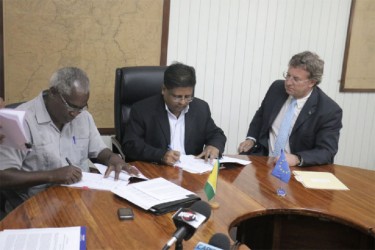The Government of Guyana yesterday signed an agreement for €14.4 million (approximately $4.1 billion) in budget financing from the European Union (EU) to bolster the country’s sea and river defences.
To qualify for this funding though, government is first required to invest in excess of $5.5 billion over the next three years to satisfy the eligibility criteria.
The funds are being made available under the 10th European Develop-ment Fund (EDF) Sea and River Support Programme, the Financing Agreement for which was signed by Finance Minister Ashni Singh and witnessed by Works Minister and EU Ambassador to Guyana Robert Kopecký in the Finance Ministry

Boardroom. Prior to yesterday’s signing though, the Agreement was signed at the EU headquarters in Brussels by Jolita Butkeviciene, Director for Latin America and the Caribbean of the European Commission’s Directorate for Development and Cooperation.
Singh yesterday explained that qualifying for the disbursement of the €14.4 million requires the satisfaction, by the Guyana Government, of “specific performance criteria in investment and performance targets, including a detailed annual implementation plan, a capacity building plan, annual condition surveys of all 160 km of manmade sea defences, and the implementation of an Annual Infrastructure Programme as outlined in the Sector Policy Implementation.”
According to a joint release, “the implementation plan for sea and river defences was developed in 2012 by the Government of Guyana to facilitate progressive adoption and enforcement of the policy by all stakeholders.” It entails an initial developmental period–2013 to 2017–during which numerous activities will be pursued as the government looks to improve the efficiency and sustainability of the Sea and River Defence Sector. Equipping the sector and placing it on the relevant path towards the satisfaction of the eligibility criteria will take three years and cost over $5.5 billion.
Speaking yesterday, Singh said that continued efforts to bolster Guyana’s sea and river defences are crucial, particularly considering the country’s topography—much of its coastal plain lies at elevations between 0.5 and 0.7 metres above mean sea level but it is threatened by tides which rise to 1.6 meters above the mean sea level. As a result, people who live and operate businesses along the coast are at constantly at risk of experiencing varying degrees of flooding.
The coast is home to approximately 90% of Guyana’s population, and is the administrative and economic centre of Guyana. Singh noted that activities conducted on the coast make the largest contributions to Guyana’s Gross Domestic Product (GDP), after mining and forestry related activities. Because of this, he said, even a moderate rise in sea levels can “decimate” the economy.
This was acknowledged by Benn. The Works Minister said that Guyana is “in a new era of rising sea levels.”
Last April, areas along the Kitty to Liliendaal stretch of the coast suffered severe flooding after sea water poured over the seawall in that area. The phenomenon was attributed to an abnormal weather pattern. Both the northern and southern corridors of that stretch of the Rupert Craig Highway were ordered closed by the Works Minister.
Kopecký, who resides along the coast and was a victim of the flooding last April, recalled the event, as well as the flooding in Parika on Thursday in stressing the need for initiatives of this nature.
Guyana’s partnership with the EU to improve sea and river defences started with the 7th EDF programme, signed on February 24th 1994. €12 million was committed by the EU under this programme. A further €20 million and €18.018 million were committed under the 8th and 9th EDF programmes respectively. This brings the total contribution by the EU to Guyana in this regard to about €50 million. These funds have been used to rehabilitate and maintain approximately 35 km of sea defence structures in regions 2, 3, 4 and 6.








